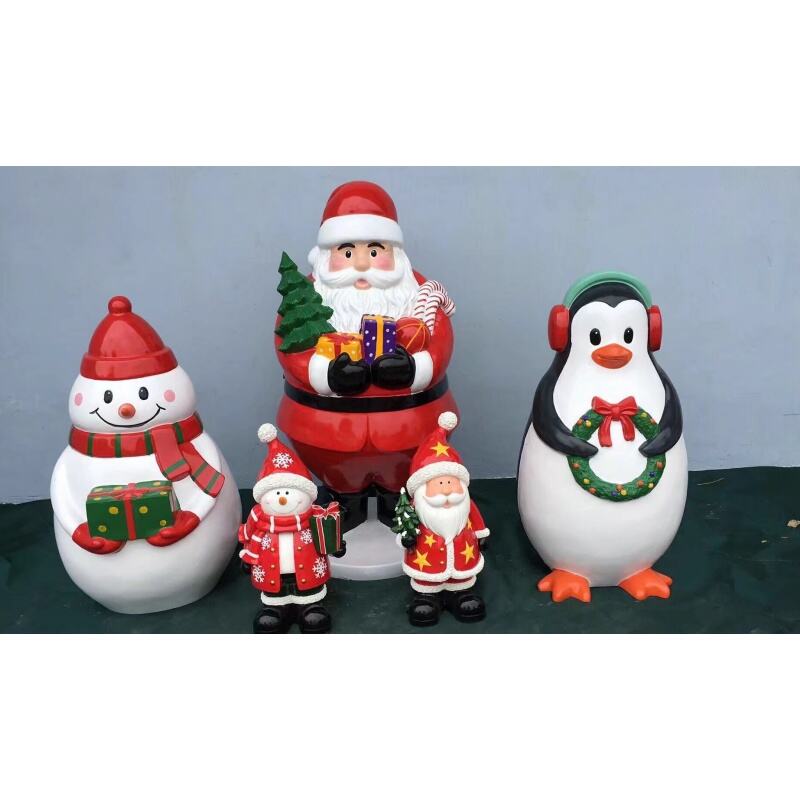Criando Instalações Artísticas Impactantes para Ambientes de Festivais
Esculturas de festivais tornaram-se parte integrante das celebrações culturais modernas, transformando espaços comuns em experiências artísticas imersivas. Essas instalações em grande escala servem como pontos focais que cativam o público e criam momentos memoráveis em eventos que vão de festivais de música a encontros culturais. O sucesso dessas obras monumentais depende fortemente da escolha dos materiais certos, que equilibram apelo estético, durabilidade e considerações práticas.
A arte de criar esculturas para festivais exige um profundo entendimento sobre diversos materiais e suas propriedades únicas. Artistas e designers precisam considerar fatores como resistência ao tempo, facilidade de transporte, requisitos de segurança e impacto ambiental ao selecionar os materiais para suas instalações. Este guia abrangente explora os materiais e técnicas mais eficazes para criar esculturas deslumbrantes para festivais que deixam impressões duradouras.
Materiais Tradicionais na Arte Contemporânea dos Festivais
Construções em Metal e Aço
O metal continua sendo um dos materiais mais versáteis para esculturas de festivais, oferecendo durabilidade excepcional e integridade estrutural. Aço, alumínio e cobre são escolhas particularmente populares entre artistas que criam instalações em grande escala. Esses materiais conseguem suportar diversas condições climáticas e fornecem a resistência necessária para esculturas altas de festivais que podem precisar permanecer no local por longos períodos.
A capacidade de soldar, dobrar e moldar o metal abre inúmeras possibilidades criativas. Os artistas podem criar padrões geométricos intrincados, formas orgânicas fluidas ou estruturas arquitetônicas robustas. Além disso, os metais podem ser tratados com diversos acabamentos e pátinas para obter diferentes efeitos estéticos, desde uma aparência bruta industrial até um acabamento polido e elegante.
Madeira e Materiais Naturais
A madeira continua sendo um material querido para esculturas de festivais, oferecendo calor e beleza orgânica que ressoa com eventos temáticos ligados à natureza. Madeira tratada, bambu e madeira reciclada são excelentes opções para criar instalações temporárias e semipermanentes. A veia natural e a textura da madeira agregam profundidade e caráter às esculturas de festival, mantendo ao mesmo tempo uma conexão com a consciência ambiental.
Artistas que trabalham com madeira devem considerar técnicas adequadas de tratamento e impermeabilização para garantir que suas esculturas mantenham sua integridade durante toda a duração do festival. Métodos modernos de preservação da madeira tornaram possível criar instalações externas duráveis que podem resistir a diversos desafios ambientais.
Materiais Modernos e Inovadores
Compósitos Leves e Plásticos
Materiais compostos avançados e plásticos tecnológicos revolucionaram a criação de esculturas para festivais. Esses materiais oferecem uma relação resistência-peso excepcional, tornando-os ideais para instalações em grande escala que precisam ser transportadas e montadas com eficiência. Materiais como fibra de vidro, compósitos de fibra de carbono e acrílicos de alta qualidade permitem aos artistas criar designs ousados e contemporâneos com suporte estrutural mínimo.
A versatilidade dos compostos modernos permite formas e estruturas complexas que seriam difíceis de alcançar com materiais tradicionais. Esses materiais podem ser moldados, modelados e coloridos de inúmeras maneiras, proporcionando aos artistas uma liberdade criativa sem precedentes, ao mesmo tempo que atendem a considerações práticas para ambientes de festivais.
Materiais Infláveis e Baseados em Tecidos
Materiais infláveis e estruturas de tecidos tensionados ganharam popularidade no design de esculturas para festivais, oferecendo possibilidades únicas para a criação de instalações temporárias e impactantes. Esses materiais permitem uma implantação rápida e um forte impacto visual, ao mesmo tempo que minimizam os desafios de transporte e armazenamento. Tecidos modernos com resistência aos raios UV e propriedades à prova de intempéries possibilitam a criação de esculturas para festivais duráveis, mas leves.
A natureza dinâmica das instalações baseadas em tecidos adiciona um elemento de movimento e interação com elementos naturais como o vento, criando esculturas cinéticas que envolvem o público de maneiras inesperadas. Tecnologias têxteis avançadas ampliaram o potencial para a criação de formas complexas e tridimensionais que podem ser facilmente modificadas ou reconfiguradas para diferentes ambientes de festivais.

Considerações Ambientais e Sustentabilidade
Materiais Reciclados e Reutilizados
A crescente ênfase na responsabilidade ambiental levou artistas a explorar materiais reciclados e reutilizados para esculturas em festivais. Materiais industriais recuperados, plásticos pós-consumo e elementos arquitetônicos reaproveitados oferecem alternativas sustentáveis, ao mesmo tempo que agregam um caráter único às instalações. Esses materiais não apenas reduzem o impacto ambiental, mas também criam narrativas envolventes sobre consumo e resíduos na sociedade moderna.
Artistas que trabalham com materiais reciclados frequentemente combinam diferentes elementos para criar esculturas híbridas que desafiam os limites tradicionais dos materiais. As obras resultantes podem servir como poderosas declarações sobre sustentabilidade, mantendo ao mesmo tempo altos padrões artísticos e integridade estrutural.
Materiais Biodegradáveis e Temporários
Para festivais com forte enfoque ambiental, materiais biodegradáveis oferecem uma abordagem inovadora para a criação de esculturas temporárias. Materiais naturais como argila, areia e compostos orgânicos podem ser usados para criar instalações impressionantes que se decompõem naturalmente ao longo do tempo. Esses materiais permitem obras específicas para o local que deixam um impacto ambiental mínimo após o término do festival.
A natureza temporária desses materiais muitas vezes se torna parte do conceito artístico, incentivando os espectadores a refletirem sobre temas como impermanência e ciclos ambientais. Os artistas devem considerar cuidadosamente o cronograma de degradação e garantir que as esculturas mantenham sua forma pretendida durante toda a duração do festival.
Considerações Técnicas para Ambientes de Festivais
Resistência e durabilidade às intempéries
O sucesso das esculturas de festivais depende muito da sua capacidade de resistir a condições externas. Os materiais devem ser selecionados e tratados para resistir à chuva, ao vento, à exposição aos raios UV e às variações de temperatura. Revestimentos protetores, reforço estrutural e sistemas adequados de drenagem são considerações essenciais no processo de design.
Os artistas devem equilibrar os requisitos de durabilidade com objetivos estéticos, recorrendo frequentemente a combinações de materiais para obter resultados ideais. Compreender os desafios ambientais específicos do local do festival ajuda a orientar as escolhas de materiais e métodos de construção.
Requisitos de Segurança e Instalação
A segurança pública é primordial na criação de esculturas para festivais. Os materiais devem cumprir as normas de segurança contra incêndios, os requisitos de estabilidade estrutural e as considerações relativas à interação com multidões. A experiência de engenharia desempenha frequentemente um papel crucial para garantir que instalações em grande escala permaneçam seguras durante todo o evento.
O próprio processo de instalação influencia a seleção de materiais, pois as esculturas devem ser projetadas para montagem e desmontagem eficientes. Técnicas de construção modular e materiais leves podem melhorar significativamente a logística, mantendo a integridade artística.
Perguntas Frequentes
Como as condições climáticas afetam a escolha de materiais para esculturas de festivais?
As condições climáticas impactam significativamente a seleção de materiais, exigindo que os artistas considerem fatores como resistência aos raios UV, resistência à água e capacidade de carga ao vento. Os materiais devem ser escolhidos ou tratados para suportar os desafios ambientais específicos do local do festival, mantendo sua atratividade estética durante toda a duração do evento.
Quais são os materiais mais econômicos para esculturas de grande escala em festivais?
Materiais economicamente viáveis frequentemente incluem metais reciclados, madeira recuperada e compósitos modernos. Esses materiais podem oferecer excelente durabilidade e impacto visual, mantendo os custos de produção gerenciáveis. A chave é equilibrar os custos iniciais dos materiais com a longevidade e os requisitos de manutenção.
Como os artistas podem garantir que suas esculturas para festivais sejam ambientalmente responsáveis?
Os artistas podem priorizar a responsabilidade ambiental utilizando materiais reciclados, escolhendo opções biodegradáveis quando apropriado e projetando esculturas para posterior reciclagem ou reutilização. Considerar todo o ciclo de vida da instalação, desde a criação até o descarte, ajuda a minimizar o impacto ambiental, mantendo a integridade artística.


